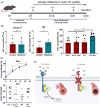The intestinal commensal fungus Wallemia mellicola enhances asthma in mice through Dectin-2
- PMID: 38331424
- PMCID: PMC10898867
- DOI: 10.1093/mmy/myae004
The intestinal commensal fungus Wallemia mellicola enhances asthma in mice through Dectin-2
Abstract
Overgrowth of the fungus Wallemia mellicola in the intestines of mice enhances the severity of asthma. Wallemia mellicola interacts with the immune system through Dectin-2 expressed on the surface of myeloid and intestinal epithelial cells. Using Dectin-2-deficient mice, we show that the interaction of W. mellicola with Dectin-2 is essential for the gut-lung pathways, enhancing the severity of asthma in mice with W. mellicola intestinal dysbiosis. These findings offer better insight into dysbiosis-associated inflammation and highlight the role pattern recognition receptors have in immune recognition of commensal fungi in the gut, leading to alterations in immune function in the lungs.
© The Author(s) 2024. Published by Oxford University Press on behalf of The International Society for Human and Animal Mycology.
Conflict of interest statement
The authors declare no competing interests.
Figures


Similar articles
-
Expansion of commensal fungus Wallemia mellicola in the gastrointestinal mycobiota enhances the severity of allergic airway disease in mice.PLoS Pathog. 2018 Sep 20;14(9):e1007260. doi: 10.1371/journal.ppat.1007260. eCollection 2018 Sep. PLoS Pathog. 2018. PMID: 30235351 Free PMC article.
-
Ovalbumin-Induced Airway Inflammation Is Ameliorated in Dectin-1-Deficient Mice, in Which Pulmonary Regulatory T Cells Are Expanded through Modification of Intestinal Commensal Bacteria.J Immunol. 2021 May 1;206(9):1991-2000. doi: 10.4049/jimmunol.2001337. Epub 2021 Apr 7. J Immunol. 2021. PMID: 33827895
-
Dectin-2 promotes house dust mite-induced T helper type 2 and type 17 cell differentiation and allergic airway inflammation in mice.Am J Respir Cell Mol Biol. 2014 Aug;51(2):201-9. doi: 10.1165/rcmb.2013-0522OC. Am J Respir Cell Mol Biol. 2014. PMID: 24588637
-
The Genus Wallemia-From Contamination of Food to Health Threat.Microorganisms. 2018 May 21;6(2):46. doi: 10.3390/microorganisms6020046. Microorganisms. 2018. PMID: 29883408 Free PMC article. Review.
-
Fungi in Gastrointestinal Tracts of Human and Mice: from Community to Functions.Microb Ecol. 2018 May;75(4):821-829. doi: 10.1007/s00248-017-1105-9. Epub 2017 Nov 6. Microb Ecol. 2018. PMID: 29110065 Review.
Cited by
-
Gut Mycobiome and Asthma.J Fungi (Basel). 2024 Mar 1;10(3):192. doi: 10.3390/jof10030192. J Fungi (Basel). 2024. PMID: 38535201 Free PMC article. Review.
References
-
- Vesper SJ, McKinstry C, Yang Cet al. . Specific molds associated with asthma in water-damaged homes. J Occup Environ Med. 2006; 48: 852–858. - PubMed
-
- Desroches TC, McMullin DR, Miller JD. Extrolites of Wallemia sebi, a very common fungus in the built environment. Indoor Air-International Journal of Indoor Air Quality and Climate. 2014; 24: 533–542.[in eng]. - PubMed
MeSH terms
Substances
Supplementary concepts
Grants and funding
LinkOut - more resources
Full Text Sources
Medical
Molecular Biology Databases

